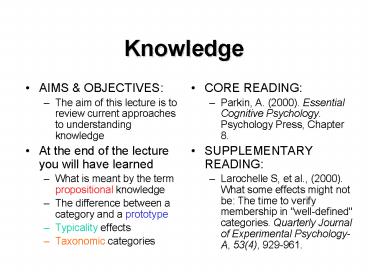Knowledge - PowerPoint PPT Presentation
1 / 25
Title: Knowledge
1
Knowledge
- AIMS OBJECTIVES
- The aim of this lecture is to review current
approaches to understanding knowledge - At the end of the lecture you will have learned
- What is meant by the term propositional knowledge
- The difference between a category and a prototype
- Typicality effects
- Taxonomic categories
- CORE READING
- Parkin, A. (2000). Essential Cognitive
Psychology. Psychology Press, Chapter 8. - SUPPLEMENTARY READING
- Larochelle S, et al., (2000). What some effects
might not be The time to verify membership in
"well-defined'' categories. Quarterly Journal of
Experimental Psychology-A, 53(4), 929-961.
2
Face recognition
Inferences If x and y then z If 4 legs and
barksdog
3
What is knowledge?
- External representations
- Turtle
- Oldest living creature
- Buries eggs etc..
- Internal representations
- Store of facts (LTM).
- Allows language etc..
- Also, allows us to make inferences about the
external environment. - This enables us to solve novel problems (145)
- Adaptive and productive.
4
hierarchy
rule based
automatic
Abstract, verbal statements
Literal, spatial relations
15.00
gillsscalestailfin
5
Exemplars and categories
- We do not encode all objects encountered in
everyday events. - We categorise each object as an exemplar of a
type on the basis that it shares features e.g.
a turtle - an amphibious creature
- long living
- slower than a hare.
- Abstract common features form a category.
- A category is a class or description of objects
or events with common attributes and the members
of categories are called instances. - People tend to think in taxonomic categories
- Furniture, vegetable..
6
ambiguous
7
Categories and concepts
Literal perceptual boundaries
- Concepts are categories of mental representations
stored in LTM memory. - Concepts are used to perceive, store, act on and
communicate about objects and events -gt false
memories. - How are conceptual categories represented in the
human mind?
Abstract independent of form
8
Defining feature theory
- Concepts defined by necessary and sufficient
attributes. - An instance is a member of a conceptual category
only if it meets minimal properties e.g., a
triangle - a two dimensional geometric figure
- with three straight sides joined at their ends
- with angles adding up to 180o
- Prediction DFT assumes clear boundaries between
members and non-members of a category. - All members of category should be equally
representative of the conceptual category. - All people should represent categories in the
same way. - BUT category boundaries are not clearly defined
or discrete. - Typicality effects.
9
Predictions of DFT
reptiles, Crawling animals
fish gillsscalestailfin
amphibious creatures
10
Typicality effects
More typical fish
11
Fuzzy boundaries
A fish?
Fruit or vegetable?
12
Eleanor Rosch
- Typicality effects (1975, JEP, 104, 192-233).
- People tend to decide that some instances are
better members than others. - Most typical furniture
- chair
- vase
- drapes
- Instances are not literally defined as members of
a category on basis of logic. - Instances have an internal abstract relative
structure. - This structure needs an organising principle.
13
Roschs prototype theory
- Conceptual categories are represented by a
prototype. - A prototype is a composite or abstraction of
features. - This combines all of the characteristics of the
most typical members of a category (fruit -
seeds, edible).
- Categorisation tasks
- Is this a fish?
- This is based on overall similarity of an
exemplar to the abstract prototype rather than on
the features of the items themselves. - This theory explains the typicality effect
because not all instances precisely resemble the
prototype.
14
Network Theory
- How are representations of knowledge arranged in
LTM - Collins and Quillian (1969) taxonomies.
- Knowledge about biological forms is organised in
a hierarchy. - General concepts are at the apex and specific
concepts are at the base.
- The superordinate level is the most inclusive
category e.g., animal. - The superordinate category subsumes more specific
subordinate categories e.g., category animals - birds, fish etc
- canary, ostrich, shark, salmon
15
Network Theory
- Individual concepts are called nodes and these
are represented by definitions based on a set of
properties. - Subordinate categories can inherit the
properties of a superordinate category. - This makes categories very economical and allows
us to draw inferences.
16
defining features
nodes
This is a type of distributed network
17
Prediction
- Sentence verification YES/NO for semantic
category decisions should be a function of the
number of levels that need to be passed to answer
a question. - Category Property Levels
- A canary is a canary can sing 0
- A canary is a bird can fly 1
- A canary is an animal has flesh 2
- A canary is a fish has gills false
18
Main effect of number of levels concept
structure
19
Neuropsychological evidence
Temporal lobe
20
Category specific agnosia
animal
- Warrington and Shallice (1984) reported a patient
JBR who had visual agnosia. - JBR had a selective deficit when asked to name
pictures from the semantic category living things
(e.g., animals) but no impairment with non-living
things and patient YOT shows the reverse pattern.
21
(No Transcript)
22
Neuropsychological evidence
- Patients with dementia seem to lose subordinate
information (e.g. canary) before superordinate
name (e.g. animal) on tests of concept knowledge. - Data consistent with idea of hierarchical
knowledge in semantic memory that supports
Collins model.
- Evidence from brain imaging suggests category
specific regions in the brain (e.g.
Thompson-Schill, 1999).
23
Thompson-Schill, et al (1999)
Living things
Non-living things
24
(No Transcript)
25
Summary
- Prototype theory assumes categories are
represented by exemplars and there is some
evidence in support. - Neuropsychological data suggests knowledge about
the world is represented in taxonomic categories
in a distributed brain network.

